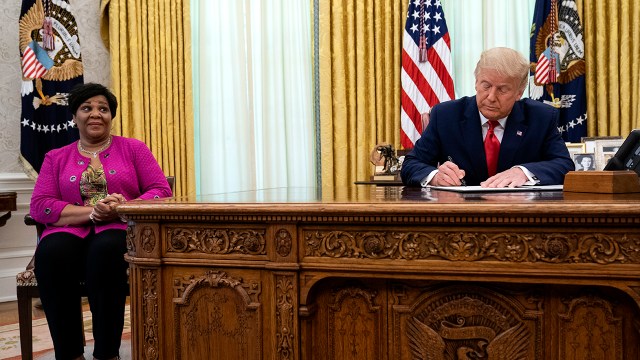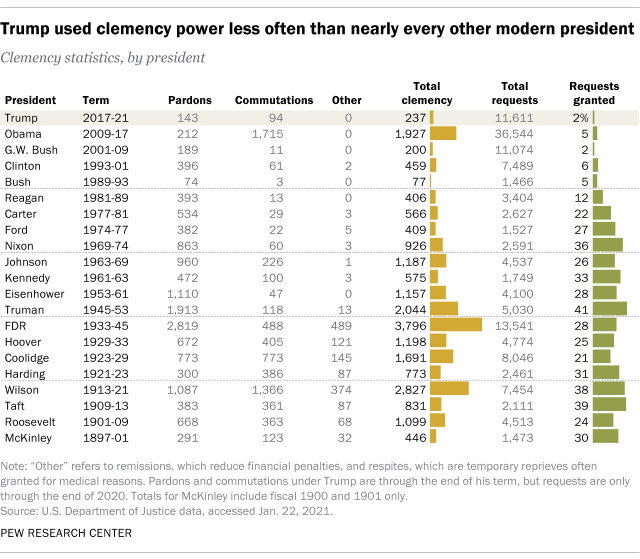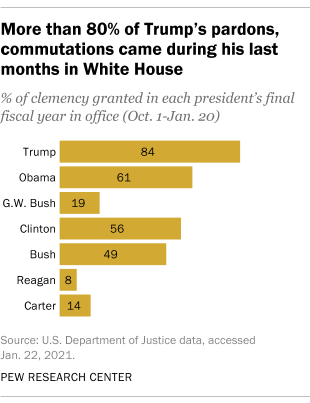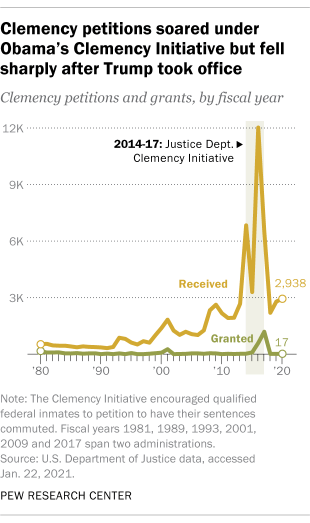Total Number of Indictments Agains Obama Staff

Despite a flare-up of pardons and commutations in his last hours in part, Donald Trump used his executive clemency power less frequently than nearly every other president since the turn of the 20th century, according to a Pew Research Middle assay of U.South. Justice Department data.
Trump granted 237 acts of clemency during his 4 years in the White Firm, including 143 pardons and 94 commutations. Just two other presidents since 1900 – George W. and George H.Westward. Bush-league – granted fewer acts of clemency than Trump.
His predecessor, Barack Obama, granted clemency ane,927 times over the grade of eight years in part, the highest total of any president going dorsum to Harry Truman. Obama'south total was skewed heavily toward commutations (1,715) instead of pardons (212).

Donald Trump concluded his presidency with a wave of pardons and commutations for those convicted or defendant of federal crimes. This assay examines how Trump compares with other mod presidents in his overall utilise of executive clemency.
All findings in this assay are based on data from the U.South. Justice Department, accessed Jan. 22, 2021. Pardons and commutations under Trump are through the end of his term, but requests are but through December 2020. The number of requests Trump received could be higher than reported here considering of additional requests he may have received in Jan 2021.
All pardons and commutations issued by Trump are counted as requests granted, even in cases when recipients did not formally petition for clemency.
Looking at the aforementioned data some other way, Trump granted clemency to simply 2% of the 11,611 people who petitioned him for it. Only George W. Bush granted clemency to a similarly small-scale proportion of applicants (2%). Trump's final percentage nonetheless could end up being the lowest on record considering the Justice Section has non yet published data on the number of applications he received in January 2021, during his final iii weeks in office.
Charity refers to multiple forms of presidential mercy. The two most mutual forms are pardons, which forgive past crimes and restore civil rights, and commutations, which completely or partially reduce sentences for those in prison or on community supervision. Two less-common forms are remissions, which reduce financial penalties associated with convictions, and respites, which are temporary reprieves that are usually granted to inmates for medical reasons.
The Justice Department'due south statistics do not count clemency granted through proclamation or executive lodge, such as the deportment taken by Presidents Gerald Ford and Jimmy Carter to forgive thousands of Vietnam-era draft dodgers.
While rare overall, Trump's use of presidential charity caused controversy because of the nature of his pardons and commutations. Many of Trump's charity recipients had a "personal or political connectedness to the president," and he ofttimes circumvented the formal process through which clemency requests are typically considered, according to analyses by the Lawfare blog.
Trump was far from the but president to face up scrutiny over his utilise of clemency. Obama'due south frequent use of commutations, peculiarly for prisoners bedevilled of drug-related crimes, prompted criticism from Republicans, who said it benefited "an entire class of offenders" and infringed on the "code authority" of the legislative branch. And President Pecker Clinton drew bipartisan condemnation for pardoning a avoiding commodities trader, Marc Rich, on his final twenty-four hour period in function in 2001.
Trump also wasn't the only president to salve many of his pardons and commutations for his final hours on the task. In fact, every president from Ford to Trump issued pardons or commutations in his last days in the White House, according to the Justice Department. Obama, for case, granted 330 acts of clemency on Jan. nineteen, 2017, and Clinton granted 177 on Jan. 20, 2001.

Trump, still, nevertheless granted an unusually big percentage of pardons and commutations tardily in his term. More than eight-in-ten of his total acts of clemency (84%) came in his final fiscal yr in office (the menstruation between Oct. 1 and Jan. 20). That was far higher than the share for other contempo presidents, including Obama (61%), Clinton (56%) and George H.W. Bush (49%).
Presidents have generally become less forgiving over time, at least when looking at the proportion of clemency requests they have granted. Every president from William McKinley to Carter granted charity to at least 20% of those who asked for information technology, according to the Justice Department data. But the percentages have fallen to the single digits for every president since George H.W. Bush, including Obama, who granted clemency to just 5% of those who petitioned him for it.

Obama's relatively depression percentage was largely due to the fact that his assistants encouraged federal prisoners to utilise for leniency nether a program known as the Charity Initiative. The programme, which launched in April 2014 and ended when Obama left part in 2017, allowed "qualified federal inmates" – those who met sure Justice Department criteria – to employ to have their prison sentences commuted.
Overall, Obama received more than 36,000 clemency petitions during his fourth dimension in office, past far the largest total of any president on record. Petitions declined sharply later on Trump took office.
Note: This is an update of a mail service originally published on December. 9, 2016, and previously updated on Nov. 24, 2020.
Source: https://www.pewresearch.org/fact-tank/2021/01/22/trump-used-his-clemency-power-sparingly-despite-a-raft-of-late-pardons-and-commutations/
0 Response to "Total Number of Indictments Agains Obama Staff"
Post a Comment